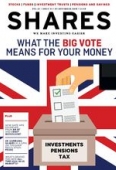Archived article
Please note that tax, investment, pension and ISA rules can change and the information and any views contained in this article may now be inaccurate.
What are consensus earnings forecasts and why do they matter?

The term ‘consensus’ is usually used to describe a broadly-accepted opinion or decision among a group of people. When applied to company earnings, it refers to the average of a collection of analysts’ forecasts.
According to the efficient market hypothesis theory, made popular in the 1970s by economist Eugene Fama, market prices should reflect all available, relevant information including earnings forecasts.
If markets are efficient, Fama argued, it is therefore impossible to beat the market because there are no undervalued or overvalued stocks left.
Stocks with high earnings growth will be valued on an appropriately high multiple of profits, while those with lower earnings growth will be valued on a lower multiple of profits.
Fans of the efficient market theory will therefore tend to buy index funds and ETFs, because they believe you can’t beat the market. On the other hand investors who disagree with the theory will try to pick out mispriced stocks on the basis that the information in the market – including analysts’ earnings forecasts – can never be perfect.
How valuable is the consensus?
In his book The Wisdom of Crowds, author James Surowiecki explored the idea that large groups of people are collectively smarter than just one or two experts.
This ‘power of collective thinking’ extends from problem-solving to decision-making and even predicting the future.
If his theory is right, putting together all the earnings forecasts of the top analysts, all using different tools and methodologies, should give you a fairly good idea of what a company’s profits will be this year and next year.
Moreover, the narrower the consensus of forecasts, in theory the more confident the analysts are that they have got it right. That means in turn that you as an investor can have more confidence when trying to work out whether or not the shares are fairly priced for the potential earnings growth.
However, as Richard Oldfield explains in investment tome Simple But Not Easy, ‘although there may be one or two outliers who predict something radically different from the average, most like to stick pretty closely to it for two reasons.
‘First, they can’t be ridiculed if their forecast is not much worse than anyone else’s. Second, in many cases they are merely parroting the “guidance” about prospective earnings which companies give.’
For analysts, ‘it is easier to repeat the company’s forecast, with a little tweak here and there, than risk the isolation, with less information than the company has, of a radically different figure’.
How reliable is the consensus?
When the economy is in a steady upward trend and background conditions are generally favourable, making forecasts is much easier than when the outlook is less certain, as it is today.
The problem, as Oldfield points out, is that even when conditions are favourable, companies themselves often make forecasts which turn out to be wrong.
The combination of a tight consensus of forecasts, led by the company, and a high valuation as investors buy into the story pushing up the share price, can result in an abrupt sell-off if – or more realistically when – the company has to lower expectations.
Recent examples of stocks where investors’ hopes were met with a cold dose of reality include home-furnishings retailer Dunelm (DNLM) and food-on-the-go purveyor Greggs (GRG), which both fell sharply after their respective managements dampened growth expectations.
The madness of crowds
In the absence of a better alternative, investors have to rely on the consensus of analysts’ forecasts as a guide to expectations of future growth. Information provider Reuters provides, free of charge on its website, consensus estimates for sales and earnings per share (EPS).
For example, investors in global banking giant HSBC (HSBA) can click here and get a synopsis of the business, consensus sales and earnings forecasts for the current year, and various key statistics such as price-to-book value and return on equity.
Investors can also go the HSBC website where the bank posts a list of analysts covering the shares and the latest consensus of financial estimates. Many other FTSE 100 companies have a similar section on their website, under the heading ‘Investors’.
How consensus earnings forecasts can help you as an investor
It is useful to look up the consensus earnings forecasts before a company issues their financial results.
You can cross reference the information once the results come out and perhaps understand why the shares moved up (did the company beat the consensus forecast?) or move down (were the results below expectations?).
CONSIDER THE GROWTH OUTLOOK
When considering analysts’ forecasts of future growth, it’s important to consider for how long growth is expected to stay at a given level. Any firm that grows faster than its peers or has higher margins will inevitably attract competition, leading to lower growth and lower returns. It is the nature of capitalism that money flows to wherever it can get the best returns.
A final word of caution comes from Burton Malkiel, author of the seminal Random Walk Down Wall Street. There are times when investors get overly enthusiastic about how long growth can continue, and stock prices end up discounting ‘not only the future but perhaps even the hereafter’.
At the level of a single stock this needn’t b e a major issue, as expectations can be re-set. When analysts and investors get carried away collectively and stop questioning the true earnings growth potential of stocks in general, it can lead to speculative stock market bubbles and eventually crashes.
Important information:
These articles are provided by Shares magazine which is published by AJ Bell Media, a part of AJ Bell. Shares is not written by AJ Bell.
Shares is provided for your general information and use and is not a personal recommendation to invest. It is not intended to be relied upon by you in making or not making any investment decisions. The investments referred to in these articles will not be suitable for all investors. If in doubt please seek appropriate independent financial advice.
Investors acting on the information in these articles do so at their own risk and AJ Bell Media and its staff do not accept liability for losses suffered by investors as a result of their investment decisions.

 magazine
magazine








